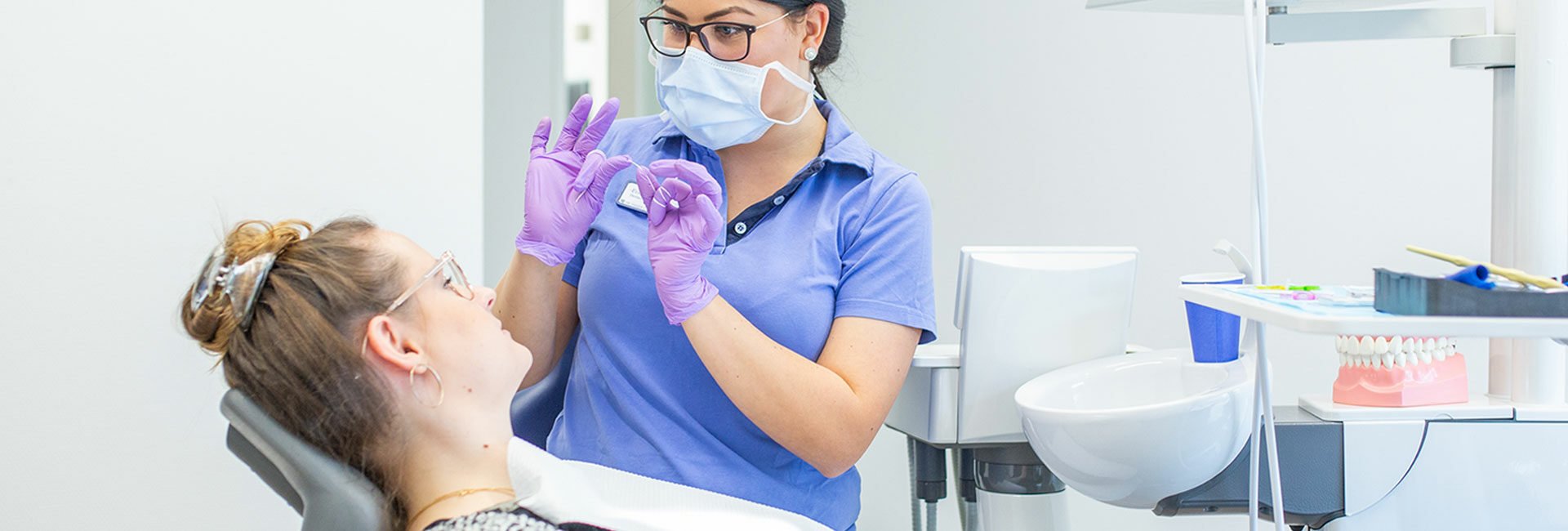
Periodontal disease
When it comes to how teeth are anchored into the jawbone, mother nature has once again produced a true masterpiece! All of the teeth are fixed into the jawbone with a slight springiness which ensures that teeth aren’t overstressed and won’t break when faced with hard foods. Give it a try: Grip an incisor between two fingers and give it a gentle waggle: you’ll be able to feel that the tooth has a little bit of give. And so the story continues: this elastic connection is also tightly sealed against bacteria in order to prevent the many bacteria present in the mouth from penetrating directly down into the jawbone lying below. The tissue that carries out this task is called the periodontium (tissues that support and surround the tooth). A great number of elastic fibres hold the tooth firmly in place in the bone, somewhat like the springs on a trampoline.
Be aware:
there is neither pain nor any other symptoms to give patients an indication that something is not right. In many cases, there may not even be any bleeding from the gums, considered a “classic sign”. Just a case of bad breath (halitosis) which results can give an indication of the presence of increased numbers of bacteria. For this reason, only during dental check-ups can inflammation of the gums be identified.

Unfortunately, there may be damage in the area concerned. Due to ineffective teeth cleaning techniques, bacteria can accumulate in these areas, and just as in the case of caries forming, they can create a permanent biofilm (plaques or ‘stains’). After what in initial stages was just a simple case of gingivitis, bacteria start to penetrate into the gums. A bacterial infection results, along with inflammation: periodontitis, or more precisely, profound marginal periodontitis. This disease is also referred to by many as “periodontal disease”. The gum surrounding the tooth has become chronically inflamed.
This means that the inflammation does not cause pain, and is retained to a certain extent by the body’s natural defences. However, the inflammation advances, with patient completely unaware, and the bacteria slowly destroy the connection between the tooth and gum. This is what creates a gingival sulcus or crevice: a cleft between the tooth surface and surrounding soft tissues, filled with bacteria. But that’s not the end of it. After some time passes, the bacterial inflammation reaches the jawbone lying below, and proceeds to destroy this too. This causes the tooth to become less stable, becoming looser and looser until it finally falls out.
This is when we come to the importance of treatment for periodontal disease: first of all, learning about effective cleaning techniques as part of our preventative treatments. To maintain healthy teeth, as for any teeth replacements already in place, it is vital to remove dental plaque found in the spaces between the teeth. Modern dental practices have a dental hygiene system in place with regular professional tooth cleaning involving a generous offer in terms of appointments and check-ups. At the Dr. Hager Dental Practice, you can count on our friendly team, all of whom have received intensive specialist training, for your preventative treatment and care of any case of periodontal disease. The initial stage of treatment involves determination of the types of bacteria involved. This involves taking a sample of the secretions from the gingival crevice for examination in a laboratory e.g. Hain testing. If disease-causing bacteria are identified during testing, an effective antibiotic against that bacteria can be selected. Whilst this antibiotic is taken by the patient, over the course of a few days, a one-off intensive cleaning of the bacterial coating is carried out in our dental practice, using local anaesthetic. This is the true treatment for the periodontal disease. Treatment success can be seen very quickly following this, with gums healing within just a few days, gingival crevices closing up, and bad breath disappearing.
However, the disease affecting certain teeth may occasionally be so advanced that effective cleaning of the root surface is no longer possible. Any such teeth must be removed before the treatment for periodontal disease is started. Otherwise, these teeth could lead to the cured teeth becoming reinfected and the success of the entire periodontal treatment would be undone. Avoiding reinfection is then the main objective during the vitally important after-care treatments relating to this disease and consistent preventative measures to be maintained thereafter. We should remember that periodontal disease comes about due to poor cleaning technique. The risk is particularly high in people that have a genetic predisposition to the disease. This explains why the clinical causes of this infectious disease can be successfully eliminated with a simple adaptation of the teeth cleaning habits maintained at home. Our dedicated dental assistants will help you with this as part of the Dr. Hager Dental Practice’s regular dental hygiene program.
“We would be delighted to show you the way to both simple, and extremely effective oral hygiene. We are all licensed practitioners, known for our thorough, but gentle approach to teeth cleaning.“
Nicole, Dental Hygienist at the Dr. Hager Dental Practice

Periodontal Disease Test
This test, especially developed by the Dr. HAGER Dentists, calculates your periodontal disease risk score using a scientific algorithm to give a well-founded estimate of your risk without the need for clinical tests.
It does not serve as a replacement for diagnostic testing by your dentist which allows for definite confirmation of whether a patient is suffering from periodontal disease or not.
For more information, please visit our page dedicated to periodontal disease, or make an appointment: Contact




The test is now complete.
By clicking on "Show test results" you will be taken to your results page.

This test, especially developed by the Dr. HAGER Dentists, calculates your periodontal disease risk score using a scientific algorithm to give a well-founded estimate of your risk without the need for clinical tests. It does not serve as a replacement for diagnostic testing by your dentist which allows for definite confirmation of whether a patient is suffering from periodontal disease or not.
For more information, please visit our page dedicated to periodontal disease, or make an appointment: Contact
Your detailed results as well as some FREE ADVICE on how to avoid periodontal disease:
Frequently asked questions
What is periodontal disease?
This dental disease is a bacterial infection and inflammation of the tissues that hold the teeth in place on the jaw bone. With bone loss left to progress over longer periods, teeth may be lost due to becoming looser and looser.
Are there any early signs indicating periodontal disease?
This disease cannot be recognised at an early enough stage by anyone other than a dental professional as the inflammation of the gums is completely painless and cannot be seen: there are almost no signs to detect periodontal disease. Even bleeding from the gums, a classic sign, often does not occur, or only occurs at a relatively late stage when there has already been some damage to the bone. In order to recognise periodontal disease, a specialist examination of the gums must be carried out by a dentist.
Are there any early signs indicating periodontal disease?
This disease cannot be recognised at an early enough stage by anyone other than a dental professional as the inflammation of the gums is completely painless and cannot be seen: there are almost no signs to detect periodontal disease. Even bleeding from the gums, a classic sign, often does not occur, or only occurs at a relatively late stage when there has already been some damage to the bone. In order to recognise periodontal disease, a specialist examination of the gums must be carried out by a dentist.
What is examined before treatment of periodontal disease?
Only careful examination of areas of inflammation and gingival crevices can reveal the signs of this type of gum disease. Laboratory testing, x-ray imaging, determining where bacterial plaques are located, and determining whether there is any tendency to bleeding may all contribute to achieving a more exact assessment of the severity of the periodontal disease.
Is periodontal disease dangerous?
International research is revealing more and more instances of damage to other organs of the body caused by the bacteria that cause periodontal disease. This includes heart attacks, diabetes, stroke, eye diseases, allergies, asthma, colonic and kidney diseases, and predisposing mothers to having premature births.
How reliable is the treatment of periodontal disease?
Since 1983, the staff working at the Dr. Hager Dental Practice have been intensively engaged with the recognition and safe treatment of periodontal disease: all of our tooth-restoration treatments are started only once the gums of our patients are healed and healthy. Healthy gums are, after all, the basis for healthy teeth. This field has been growing and developing at its very basis for a long time, and the treatment methods have experienced revolutionary changes. Just recently, Swiss researchers have made fundamental advances in this field: Prof. H.R. Mühlemann (Uni Zürich), Prof. J.F. Roulet, Genf, Prof. Renggli (Uni Zürich u.a.), Th. Marthaler, Basel.
How you can help me with my case of periodontal disease?
In the Dr. Hager Dental Practices, our dentists can provide patients an effective and scientifically-proven treatment approach for periodontal disease. Our specialised and highly-trained staff will use comprehensive diagnostic techniques and advanced treatment methods to help you to achieve long-lasting and healthy gums. Enjoy the results of fresh breath, strong teeth, and a new sense of well-being.
Do mouthwash products help in cases of periodontal disease?
Do any loose teeth also need to be removed?
Teeth that have been very seriously affected cannot be cleaned effectively and must therefore be removed.
How much does the periodontitis treatment cost?
The costs relating to treatment of periodontal disease vary greatly depending on each individual case. After comprehensive diagnostic testing and a meeting to discuss the results, you will receive an exact quote before you have to decide on whether or not to go ahead with the periodontitis treatment.
After treatment, will I be cured of periodontal disease forever?
To ensure treatment success, regular professional cleaning sessions should be carried out, (also termed “dental hygiene appointments”) both before treatment and after. This is due to the fact that the regular and thorough elimination of bacterial biofilm from teeth is absolutely vital to avoid the disease returning.